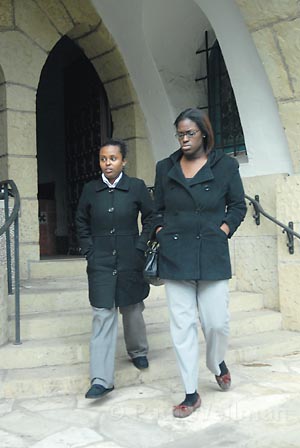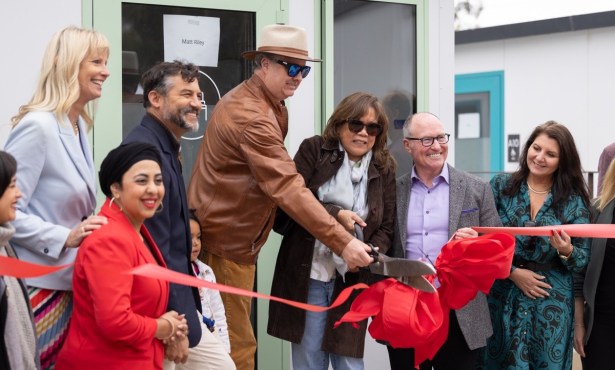Cooney’s Case Goes to Jury
Verdict Could Affect Pending Civil Suit Against Police

It’s a trial with two tales.
One tale-presented by prosecutor Paula Waldman and based on testimony from several Santa Barbara police officers, a few witnesses, and three experts-portrays defendants Meron Meshesha and Aseye Allah as obstructing and delaying police officers trying to calm a riotous crowd, which became enraged after Donald Blivens punched Reggie Smith and the police arrested Blivens.
Allah felt she was “above the law and stubborn,” yelling at police and surging forward toward a police line, Waldman said. “Her emotions drove her that night, not common sense.” In Waldman’s tale, Meshesha ignored numerous police orders to back away from Reggie Smith and grabbed Officer Andre Feller’s arm, who subsequently arrested her in a professional manner. “They stood out in the crowd and that’s why they were arrested,” Waldman said.
The other tale-told by defense attorney Gary Casselman and supported by a bevy of witnesses, one expert on police conduct, and the two defendants, who are both black-gives the story of a crowd that was celebratory but calm two nights before many of its members were to graduate from UCSB. That was, at least, until what Casselman called the unlawful arrest of Meshesha, who, after trying to help her friend Smith, was thrown to the ground, her head hitting the pavement. She was then dragged to a patrol car, during which her breasts became fully exposed and she received scrapes on her arm. She never heard directions from officers. Allah, peacefully trying to direct pedestrian traffic and move people back while wondering what happened during Meshesha’s arrest, was swept off her feet by an officer, taken to the ground, and also arrested.
Casselman never brought up race during the trial, though Waldman often asked race-related questions. Tuesday afternoon, jurors began trying to figure out which version of the story actually took place the night of June 16, 2006. By Wednesday morning, no verdict had been reached. While the two women face serious consequences should they be found guilty of the misdemeanor offense of obstructing a peace officer-it would mean a fine and probation at minimum, a year in jail at maximum-the consequences of an acquittal could be even more serious, and expensive, for the city.
The two women filed a civil lawsuit in U.S. District Court on June 26, naming 16 law enforcement officers from the Santa Barbara Police Department, as well as Chief Cam Sanchez and 10 unidentified defendants. That case has been dismissed pending the outcome of the misdemeanor trial. Casselman, who is also representing the women in the civil case, said he didn’t consider the dismissal a setback, as the suit hadn’t made its way very far down the line. The suit listed 18 complaints for damages, including allegations of suppression of free speech, a conspiracy to interfere with civil rights, battery, excessive force, negligence, and unlawful arrest. If the two are acquitted in the criminal case, it seems the civil suit would resume.
Should they be convicted, however, they could still presumably go forward with their civil action, but a judge might be more inclined to throw it out since the police actions would have been found lawful and Meshesha and Allah to have been breaking the law. Case law seems to support this. In Heck v. Humphrey, the U.S. Supreme Court decided that civil action suggesting unlawful police acts leading to arrest and conviction is barred if the plaintiff was found convicted of the crime. While it was never brought up during the trial, the importance of the jury’s decision in terms of the civil case seems obvious.
Local attorneys and prosecutors alike can’t remember a misdemeanor trial lasting as long as this one. According to defense attorney Casselman, the civil suit is definitely a contributing factor to the length of the trial. Darryl Perlin, who prosecuted misdemeanors for several years, said his longest experience for one case was 10 court days. This trial began January 2. One of the reasons this case ran so long, Perlin presumed, was the volume of witnesses to the alleged misdemeanors. The fight broke out when Cooney’s (now EOS Lounge) was letting out for the night, meaning roughly 300 people were exiting the club near the corner of Anacapa and Haley streets.
This wasn’t the only recent case in court revolving around alleged police misconduct in Santa Barbara. A federal jury in Los Angeles recently rejected claims of police brutality leveled against four Santa Barbara police officers, including Feller, by Shawn Comrie, who said he was pummeled by police while dressed as The Incredible Hulk on Halloween in 2004. Comrie sued after being found not guilty of being drunk in public.
Allah, 23, is currently in the middle of her master’s degree in social work at the University of Pennsylvania in Philadelphia, where she has an internship working with a number of underprivileged children as a mentor and counselor. Each day of the trial has meant one less day that Allah can attend her internship, putting her in danger of not getting needed credit this semester.
Meshesha, 24, still lives in Santa Barbara and is studying for the California Real Estate Exam while working at a spa. She also has plans to attend the West Los Angeles College of Business. According to Casselman, after the incident, neither woman wants to stay in Santa Barbara. The experience has been a “nightmare” for the both of them, he told the jury. The two have been in court every day, sitting behind Casselman-whose Web site lists police misconduct as one of his areas of expertise-and Dana Rosenberg, who is volunteering her time to assist with the case. Neither attorney is being paid. “We got involved because we believe in our clients,” Casselman said.
Prosecutor Waldman declined to comment until after the jury came back with a decision, but speaking to the jury during her closing argument, she said that police acted appropriately and the women did not. “The truth is that on June 16, 2006, police officers did an excellent job at handling this riot situation thrown at them,” she said.
Casselman differed. “If you examine the facts dispassionately, carefully, you will see” that the two defendants did nothing wrong, he told the jury, which is composed of eight men and four women, one of whom is black. “This was an ass-covering exercise,” Casselman said after the proceedings.


